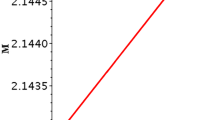With the help of an exact solution of the Einstein and Maxwell equations, the internal structure of a multiply connected space of wormhole type with two unclosed static throats leading out of it into two parallel vacuum spaces or into one space is investigated in GRT for a free electric field and dust-like matter. The given geometry is considered as a particle–antiparticle pair with fundamental constants arising in the form of first integrals in the solution of the Cauchy problem – electric charges ±e of opposite sign in the throats and rest mass m0 – the total gravitational mass of the inner world of the particle in the throat. With the help of the energy conservation law, the unremovable rotation of the internal structure is included and the projection of the angular momentum of which onto the rotation axis is identified with the z-projection of the spin of the charged particle. The radius of 2-Gaussian curvature of the throat R* is identified with the charge radius of the particle, and the z-projection of the magnetic moment and the g-factor are found. The feasibility of the given gravitational model is confirmed by the found condition of independence of the spin quantum number of the electron and the proton s = 1/2 of the charge radius R* and the relativistic rest mass m* of the rotating throat, which is reliably confirmed experimentally, and also by the coincidence with high accuracy of the proton radius calculated in the model R*p = 0.8412·10–13 cm with the value of the proton charge radius obtained experimentally by measuring the Lamb shift on muonic hydrogen. The electron in the given model also turns out to be a structured particle with radius R*e = 3.8617·10–11 cm.
Similar content being viewed by others
References
Yu. A. Khlestkov, Zh. Eksp. Teor. Fiz., 128, No. 2, 300–311 (2005).
Y. A. Khlestkov and L. A. Sukhanova, Foundat. Physics, 46, No. 6, 668–688 (2016).
Y. A. Khlestkov, L. A. Sukhanova, and N. S. Trushkin, Chin. J. Phys., 54, No. 4, 614–627 (2016).
P. A. M. Dirac, Proc. R. Soc. A, 117, No. 778, 610–624 (1928).
R. Pohl et al., Nature, 466, 213–217 (2010).
R. K. Adair, The Great Design: Particles, Fields, and Creation, Oxford University Press (1989).
L. D. Landau and E. M. Lifshitz, Quantum Mechanics: Non-Relativistic Theory, Pergamon, London (1977).
L. D. Landau and E. M. Lifshitz, The Classical Theory of Fields, Butterworth-Heinemann, London (1975).
Yu. S. Vladimirov, Geometrophysics [in Russian], Binom, Moscow (2005).
N. R. Sibgatullin, Oscillations and Waves in Strong Gravitational and Electromagnetic Fields [in Russian], Nauka, Moscow (1984).
G. Krein, Usp. Fiz. Nauk, 96, No. 1, 153–167 (1968).
S. W. Hawking and G. F. R. Ellis, The Large-Scale Structure of Space-Time, Cambridge University Press (1975).
Author information
Authors and Affiliations
Corresponding author
Additional information
Translated from Izvestiya Vysshikh Uchebnykh Zavedenii, Fizika, No. 1, pp. 72–86, January, 2018.
Rights and permissions
About this article
Cite this article
Khlestkov, Y.A., Sukhanova, L.A. Internal Structure of Charged Particles in a GRT Gravitational Model. Russ Phys J 61, 76–93 (2018). https://doi.org/10.1007/s11182-018-1370-1
Received:
Published:
Issue Date:
DOI: https://doi.org/10.1007/s11182-018-1370-1



